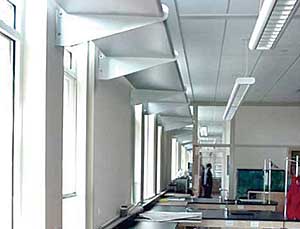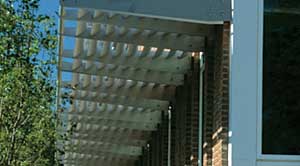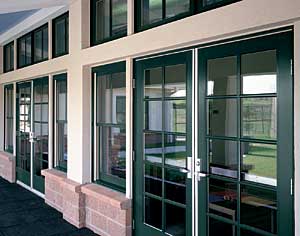Building Green with Windows and Doors
Window Features and Criteria
Energy efficiency is clearly the dominant feature in specifying windows and doors for Green Building. But other factors such as use of recycled materials, recycling of waste and source of raw materials, count and are included where relevant, in the descriptions of window components below.
Architects specifying windows and doors will find no lack of information on energy efficiency, performance and durability. New advanced technologies and designs for glass coatings, gas fills, warm edge spacers and improved framing have all contributed to efficiencies. Manufacturers, government agencies and industry associations analyze components, make comparisons and develop ratings. Some features are certified by independent bodies. Others follow voluntary criteria developed by manufacturers' associations.
|
The National Fenestration Rating Council (NFRC) uses three criteria associated with energy as a guide to understanding how a window or door will perform:U-Factor, Solar Heat Gain Coefficient andVisible Transmittance. The building industry also measures theFading Transmission, R-Value andCondensation Resistance to help evaluate a window's performance. All of these numbers have different significance and desired values depending on the region of the country (seewww.nfrc.org).
|
*TheU-Factor = BTU/hr x sq ft x °F measures therate of heat loss through the window. The lower the U-Factor, the better the window is at keeping heat from escaping. The R-Value measures a window'sresistance to the passage of heat. Thehigher theR−Value, the better the insulating value of the window. Both the U-Factor and the R-Value are a measure of the amount of thermal transfer for any given window. Since the R-Value is the inverse of the U-Factor, both numbers can be calculated if one of the numbers is known. For northern climates, the Efficient Windows Collaborative (EWC) (www.efficientwindows.org) suggests the use of windows with a U-Factor below .40, while in the southern part of the United States, a U-Factor of less than .65 is desirable.
Product U-Factor and R-Values are determined by computer simulation using LBL THERM and Window software applications. LBL is part of the Lawrence Berkley National Laboratories (LBNL), a national lab funded in a large part by the U.S. Department of Energy.
*TheSolar Heat Gain Coefficient (SHGC) is the fraction of available solar heat that successfully passes through a window or door. SHGC replaced shading coefficient (SC) as a more accurate way to calculate solar-heat gain. SHGC uses a scale of 0 for none, to 1.00 for 100 percent of available heat.
|
Thelower the SHGC, the better the window's ability to block heat from the sun. Therefore, in climates where the heat of the sun needs to be kept out of a building, a low SHGC is specified, while in cold climates where most of the year is spent trying to bring the heat into a building, a high SHGC is specified. The EWC recommends that windows in Southern Zones of the United States have a SHGC factor of 0.40 or less. Different types of tints and coatings can drastically help to lower the SHGC and block unwanted heat gain.












